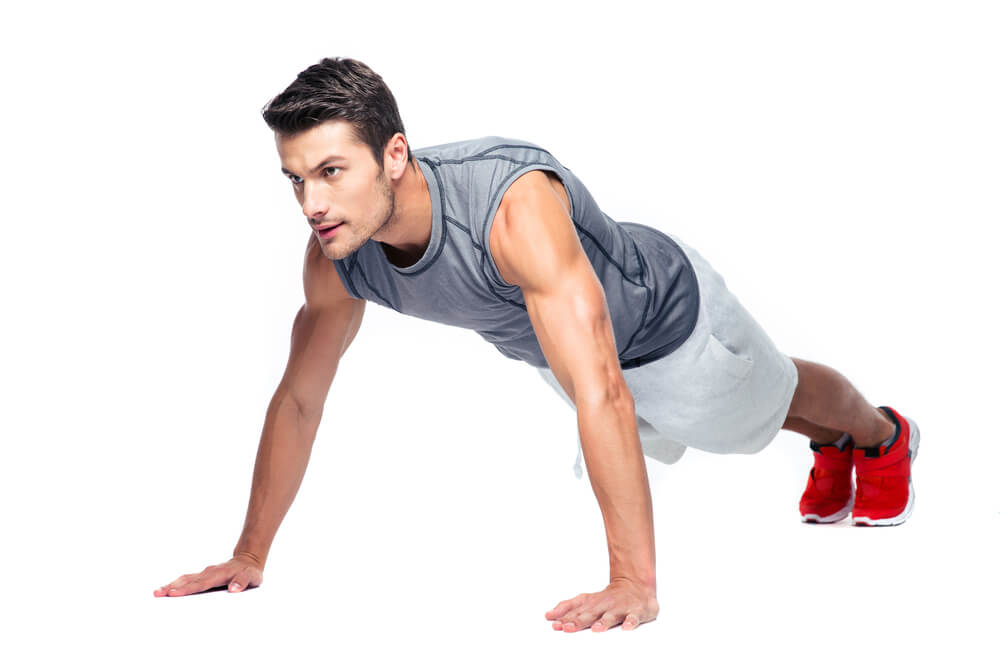
Wouldn’t it be great if you could build muscle and improve your strength by standing still? You could literally sit on the couch all day, watch football, and just feel your muscles grow stronger. Today we are going to explore Isometric exercises.
Now, the only thing that might grow when spending all day on the sofa is your gut, but it is possible to put on muscle without physically moving. It is possible through something known as isometric exercises.
This kind of workout isn’t simply standing or sitting without putting any kind of effort into it. You’ll put in a considerable amount of work (more than you ever thought you could without moving), but it is a nice change of pace workout over what you may currently do.
What exactly are isometric exercises, and what are some moves (if any) that help you put on muscle?
Keep on reading, because we’ve got the goods for you.
Three Kinds of Muscle Training
When you think about it, your muscles are relatively limited in terms of movement.
You’re not an octopus with swirling tentacles going every witch way. We’re also willing to bet you’re not part of the Stretch Dude and Rubber Girl tandem (or any other odd superhero) that gives you an elastic body. With the way your muscles are attached to bones and jointed formed with ligaments in your body, you can only move in certain ways (despite how hard you try pulling the head turning Exorcist move, it just doesn’t work). Because your body can only move in certain ways, there are only a few basic ways to train your muscles.
These three ways are known as eccentric, concentric and isometric.
We’re also willing to bet you’re not part of the Stretch Dude and Rubber Girl tandem (or any other odd superhero) that gives you an elastic body. With the way your muscles are attached to bones and jointed formed with ligaments in your body, you can only move in certain ways (despite how hard you try pulling the head turning Exorcist move, it just doesn’t work).
Because your body can only move in certain ways, there are only a few basic ways to train your muscles. These three ways are known as eccentric, concentric and isometric.
If you really stopped and looked at each word, chances are you can figure out what each one represents, as the movement is within the word. Concentric is where you contract the muscle. Think of you curling weight. The concentric movement is when you have restricted the muscle (at the top of the curl).
The second kind, or eccentric, is when you extend the muscle. It is when your arms are fully extended down during the curl movement. Many personal trainers will preach about the importance of eccentric exercises in order to stretch the muscle further in order to put more tension on it. It’s why so many people love the incline curl, because it increases the eccentric stretch of the muscle at the base of the move.
The third exercise movement type is isometric. As the name suggests, you isolate the muscle, but you don’t move it at all. It remains isolated.
How Can You Train Your Muscles By Not Moving Them?
Alright, so isometric training is where you don’t move your muscles at all.
How in the world is this actually training?
Well, let’s start by saying you’ve probably done this throughout the week without actually knowing it.
Have you ever tried to push a car, but it wouldn’t budge?
As a kid, did you ever pretend to push a large rock to see if you could move it?
Whatever you were pushing against, you put in a good amount of effort, yet you never actually moved your muscles. You may have even been winded and tired from attempting it, despite never flexing or moving muscles. This is exactly what isometric exercises entail. You push out your maximum energy without actually any concentric or eccentric muscle movement.
Where did Isometric Training Come From?
We’ve all tried to move something that we couldn’t.
That’s been going on for forever.
Chances are, back in the caveman days, there was one caveman trying to impress a cavewoman by pushing a boulder, only to not have it move (no matter how hard he tried). The fact is, pushing objects without any response is nothing new.
However, the concept of using it as a means of training the muscles didn’t really come about until around 100 years ago.
Muscle training has generally focused around the lifting of heavy objects.
Even if there wasn’t the same kind of understanding regarding muscle movement and how the body works, the idea of lifting heavier objects to become stronger has been around since the time of Ancient Greece (Galen, a Greek physician wrote about strength training using an object similar to the modern dumbbell). So isometric training is relatively new when looking at the grand scheme of weight training (United States Sports Academy, 2010).
Alexander Zass fought for the Russian army during the First World War. Without diving too much into a world history lesson, many Russian soldiers were not exactly sure if they should even be in the war (Russia primarily fought against Austria) due to the revolution taking place back home.
Due to this, a large percentage of Russian soldiers were captured. Zass was captured and taken prisoner during the war. In fact, he was taken prisoner four times throughout the course of the war (let’s just say he’d give Steve McQueen a run for most POW breakouts).
While in captivity, Alexander kept his body strong by pulling and pushing on the bars and chains used to secure him in a cell. Supposedly, one of his breakouts did revolve around him actually pulling the chains apart, but that may be more speculative myth than anything else. Regardless of if he broke out in this manner or not, Alexander discovered the benefit of isometric training.
After all, he didn’t have weights or heavy objects to train with, yet he saw the need to remain fit (if you look up any images on Alexander Zass, you’ll likely be impressed by his physical fitness, especially considering many of the pictures were taken in the 1920s or earlier) (Breaking Muscle, 2013).
Following the conclusion of the war, Alexander went on to write books on isometric training and taught the concept of it to others.
Isometric training has never been as sexy as lifting large weights, but it is a viable training option and one you should consider at least adding to your workout routine.
Why Isometric Exercises Work
Alright, so some Russian dude back 100 years ago was able to maintain his strength by pulling on bars.
That’s great and all for him, but how does it work for you and how exactly does it work?
It all comes down to keeping your muscles engaged. Think of the Farmer’s Walk exercise. With it, you don’t actually move the weight. You hold onto loaded up dumbbells and basically go for a walk while holding the weight at your side.
When it’s all said and done, your arms will be torched, your forearms will want to fall off, and your entire backside may be on fire. The Farmer’s Walk, in ways, can be considered an isometric exercise because you are not flexing or stretching the muscles. The exercise works because your muscles are engaged the entire time. By remaining engaged, the tension causes your muscles to rip and break down.
Due to this, your muscles require additional proteins to build up and repair the damaged muscle tissue, which results in larger muscles. It’s also why it is generally recommended to hold your weight (or move) when fully engaged (like with a squat, it is best to hold it in the fully engaged down position for a few moments before pushing up). Chances are, you have some isometric elements to your weight workouts because of this. Whatever moves you do though, it comes down to isolating and not moving the muscles while keeping the muscles engaged (Greatist, 2017).
How to Perform Isometric Exercises
Before we get into a few of our favorite isometric exercises, it is necessary to cover the ground rules first.
For starters, you want to squeeze the muscle.
Don’t just pussyfoot the squeeze either.
You want to really squeeze it hard. If you want to get technical (you likely don’t, but we’ll mention it anyway), it is referred to as maximal voluntary contraction. Essentially, you squeeze your muscle as tight and as hard as you can. While you shouldn’t try to hurt yourself by going over the top, you should put in a good, solid squeeze during the move.
The second point to keep in mind is to breathe. Far too many people hold their breath when performing isometric exercises (in reality, far too many people hold their breath when lifting as well). This is the last thing you want to do.
You need oxygen running through your body. So make sure to maintain your breathing whenever performing isometric exercises (Style Craze 2017).
The Best Isometric Exercises
There are all sorts of isometric exercises we could get into.
Some though we just don’t find much of a benefit.
There are websites that will tell you to do a wall extension or “self-arm wrestling.” These are okay and all, but we believe you should only do an exercise if it is going to be better than other options and actually deliver benefits.
We’re really not going to tell you to do self-arm wrestling unless you’re waiting for your date in the car and you want a last minute pump to get your veins popping. Other than that, this kind of an exercise isn’t going to train you all that much.
There’s also the classic plank, which is an isometric exercise intended to target your body’s core. It is extremely popular, but in reality, there are better options for you (which is why we’re not going to talk about the plank here). In reality, you can add a twist or a side crunch to the plank and instantly make it better. We want you to have the best moves possible.
So, here are the best exercises that will really train your body and help you put on muscle.
Isometric Pushup
With this move, you’ll be in a similar position as a regular pushup. Now, push up about half way, so your arms are parallel to the ground. Hold it here and keep your entire upper body (and abs) tight. With this (and all other moves) you can either hold it until your body gives out. Or, you can do one rep of 10-20 seconds, return to start, and then repeat for 10 reps.
Hanging Out
Want to really blast your shoulders and back without any weights?
Just hang out.
Find a pull-up bar (or anything you can hang from), then take a grip and simply hang there. You’ll burn your entire upper body (not as much your chest though) and murder your grip. Again, either hold there until you give out, or perform 10 reps of 10-20 seconds each.
Farmer’s Walk
We’re adding this one here because even though you’re performing an isometric exercise doesn’t mean you can’t use weights. With the Farmer’s Walk, you load up dumbbells and just walk.
Don’t have room to walk?
Not a problem, you can stand still. With this move, hold it there until you can’t hold it any longer. Fight through the pain as long as you can, it really helps build your shoulder and back muscles.
Bridge
The glute bridge is a great non-weight move for building strength (and size) in your booty while improving your core strength.
With the move, start on your back, feet flat on the floor. Now, push your putt up off the ground, like you’re trying to push it through your belly button. Keep a flat back for this. Hold this move for as long as you can while squeezing your butt. If you’re just starting out, follow the 10-20 second for 10 reps option.
Wall Sit
This one is always a killer. You know what we’re talking about.
Find a wall, pretend like you have a chair, and push your back against it.
Hold as long as you can.
Want to make it more challenging?
You can sit so your butt is lower than parallel to your knees. This puts, even more, pressure on your lower body. You can also lift out one leg at a time every 10 seconds or so.
Conclusion
Isometric exercises are great additions to any workout. Ideally, you shouldn’t use these as a workout, but in a pinch most can work when you’re short on time, or as exercises at the tail end of your normal workout (nothing like a good wall sit at the end of leg day to finish). You may not escape from any prison camps with these moves, but you will start to see size develop. So try out these moves during your next workout!
So try out these moves during your next workout!
-Terry Asher
Terry Asher
Latest posts by Terry Asher (see all)
- Better Family – Product Review Liquid Daily 2 oz - Dec 16, 2024
- Post-Workout Recovery: The Key to Optimal Performance - Nov 25, 2024
- Pre-Workout Supplements – Everything You Need To Know - Nov 18, 2024

















I am suffering with backbone pain and doctor said that i have week back muscles. I am trying to make my muscles strong. I was looking for some exercises and workout options and you made my job easier here. Thanks for your wonderful stuff.
Who does not want a super toned and slim body? I know I do, but what I don’t like doing is working out! Yeah! The sad truth of life! So, that is why, when I came to know about the workout where you needn’t move a muscle but you still end up getting a great workout, then isometric workouts is just right for you and me!
[…] this all you need is a simple chair. Start the exercise on your side, as if you’re going to do an oblique plank (although you can have your side resting completely against the […]
[…] this all you need is a simple chair. Start the exercise on your side, as if you’re going to do an oblique plank (although you can have your side resting completely against the […]
[…] this all you need is a simple chair. Start the exercise on your side, as if you’re going to do an oblique plank (although you can have your side resting completely against the […]
Whats Going down i’m new to this, I stumbled upon this I’ve discovered It positively helpful and it has helped me out loads. I am hoping to give a contribution
Magnificent goods from you, man. I’ve understand your stuff previous to and you are just extremely magnificent. I really like what you’ve acquired here, really like what you are saying and the way in which you say it. You make it entertaining and you still take care of to keep it smart. I can not wait to read far more from you. This is really a tremendous website.|
Attractive section of content. I just stumbled upon your site
and in accession capital to assert that I get in fact enjoyed account your blog
posts. Any way I’ll be subscribing to your feeds and even I achievement you access consistently
quickly.
Great post. I was checking constantly this weblog and I am inspired! Extremely useful information specially the ultimate section 🙂 I deal with such information a lot. I was looking for this particular info for a long time.Thanks and best of luck.
[…] not mistake isometronic exercises for isometric exercises, there is a difference between those two. In an isometric exercise we are squeezing the […]
[…] not mistake isometronic exercises for isometric exercises, there is a difference between those two. In an isometric exercise we are squeezing the […]
I discovered your blog site on google and check a few of your early posts. Continue to keep up the very good operate. I just additional up your RSS feed to my MSN News Reader. Seeking forward to reading more from you later on.
I’m truly enjoying the design and layout of your website.
It’s a very easy on the eyes which makes it much more enjoyable
Good web site you have here.. It’s hard to find high quality writing like yours nowadays. I really appreciate people like you! Take care!!
Great tremendous things here. I’m very glad to look your article. Thank you so much and i am taking a look ahead to contact you. Will you please drop me a mail.